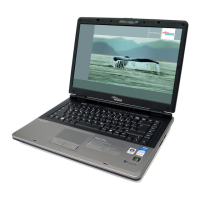Working with t he notebook
Permanently unlit or lit pixels
The standard of production techniques today cannot guarantee an absolutely fault-free screen
display. A few isolated constant lit or unlit pixels may be present. T he maximum permitted number
of pixels faults is stipulated in the strict international standard ISO 13406-2 (Class II).
Example:
A 15" LCD screen monitor with a resolution of 1280 x 800 has 1280 x 800 = 1,024,000 pixels. Each
pixel consists of three subpixels (red, green and blue), so there are almost 3 million subpixels in
total. According to ISO 13406-2 (Class II), a maximum of 4 pixels and 5 s ubpixels may be defective,
i.e. a total of 17 defective subpixels. T hat is approx. 0,0005 % of the entire subpixel!
Background lighting
TFT monitors are operated with background lighting. The luminosity of the background
lighting can decrease during the period of use of the notebook. However, you c an
set the brightness of your monitor individually.
Screen settings
Settin g the re solution
LCDscreen
The screen resolution of the L
CD monitor of your notebook is optimally set a t the factory.
Changing the font size
Changingt he fontsizeLCDscreen
You can choose between a larger
and a smaller font.
► Right-click on the desktop. En
ter your settings b y clicking Personalization – Adjust Font Size
(DPI) (in the left pane) – Cont
inue.
or
► Enter your s ettings by clicki ng Start – (Setting s ) – Control Panel – Appeara nce and
Personalizati on – Persona lization – Adjust Font Size (DPI) (in the left pane ) – Contin ue.
Synchronising the display on the LCD screen and an external monitor
LCDscree
n
MonitorSynchron
isation, screendisp lay
Your notebook supports simultaneous display on the LCD screen and an external monitor.
Pressing the key combination
Fn
+
F10
switches between LCD m onitor only, external
monitor only and LCD and external monitor. The last setting is useful if you would like
a high resolution and a high refresh rate on an external monitor.
28 AMILO Notebook operating manual, edition 3

